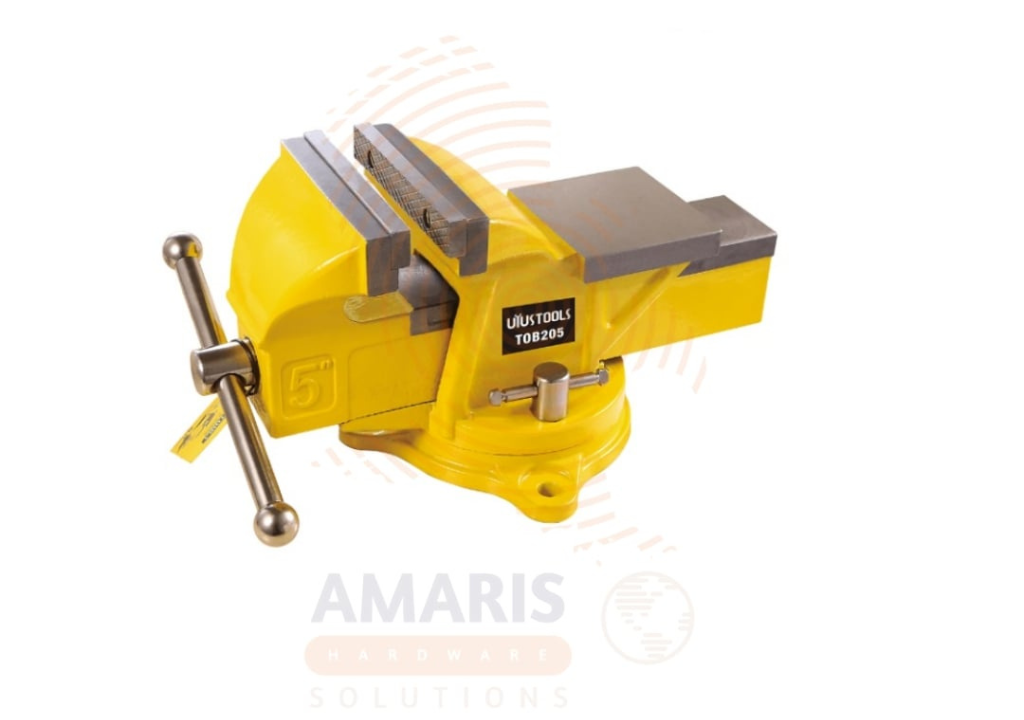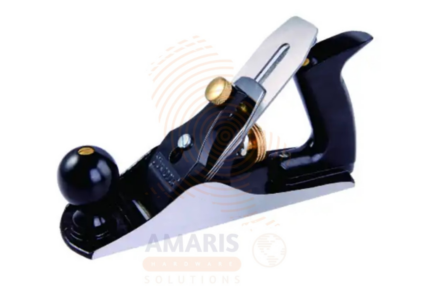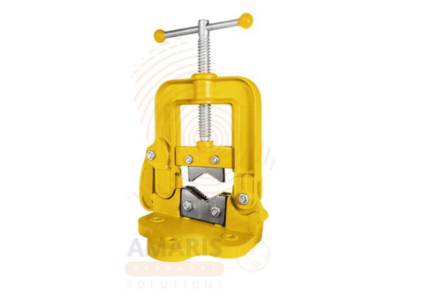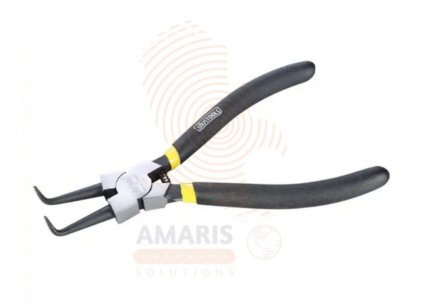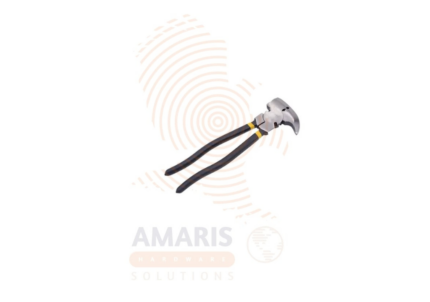Bench Vise
WhatsApp Order
A bench vise is a mechanical device designed for securely clamping objects to a workbench or similar surface. It typically consists of two jaws—one fixed and the other movable—operated by a threaded spindle. The jaws can be tightened or released to hold an object firmly in place, providing stability and support for various tasks such as woodworking, metalworking, or other manual work. Bench vises are essential tools in workshops and are commonly used for tasks that require precision and a stable work holding solution.
Categories: HAND TOOLS, Pliers & Cutters
Tags: bench clamp, bench vise, clamping tool, durable vise, hand tool, metalworking vise, precision clamping, woodworking vise, workshop vise
Description
Table of Contents
ToggleBench Vise
Uses
-
Woodworking: Holding and securing pieces of wood for sawing, chiseling, planning, or carving. The vise provides stability and ensures accurate and controlled cuts.
-
Metalworking: Clamping metal pieces for cutting, filing, grinding, welding, or other fabrication tasks. The vise allows for precise manipulation and shaping of metal components.
-
Assembly and Repairs: Holding parts or components in place during assembly or repair work. This is particularly useful for tasks that require both hands, allowing the worker to focus on specific actions without worrying about holding the workpiece.
-
Machining: Supporting materials during machining operations such as drilling, milling, or tapping. The vise helps to secure the workpiece in a fixed position, preventing movement or vibration during precision machining processes.
-
Plumbing Work: Holding pipes or fittings securely for cutting, threading, or soldering. The vise ensures a stable platform for plumbing tasks, facilitating accurate and safe work.
-
Jewelry Making: Clamping small and delicate jewelry pieces for intricate and detailed work, such as soldering, polishing, or engraving.
-
Electronic Repairs: Securing electronic components or circuit boards for soldering, de soldering, or other delicate repair tasks where stability is crucial.
-
Model Making: Holding miniature components or models in place during construction, painting, or detailing.
-
Leatherworking: Clamping leather pieces for cutting, stitching, or tooling. The vise provides a stable platform for precision in leatherworking tasks.
-
General Work holding: Supporting various materials for tasks like gluing, sanding, or finishing. The bench vise is a fundamental tool for holding workpieces securely during a wide range of manual tasks.
SAFETY HANDLING PRECAUTIONS
Safety Precautions
-
Read the Manual:
-
Familiarize yourself with the manufacturer's instructions and guidelines provided in the manual for the specific bench vise you are using.
-
-
Inspect the Vise:
-
Regularly inspect the vise for any signs of damage, wear, or malfunction. Ensure that the jaws, spindle, and other components are in good condition before use.
-
-
Secure Mounting:
-
Mount the bench vise securely to a stable workbench or surface using proper bolts and fasteners. The vise should be rigidly attached to prevent movement during use.
-
-
Proper Positioning:
-
Place the workpiece securely within the vise jaws, ensuring that it is properly aligned and centered. Avoid overloading the vise with a workpiece that exceeds its recommended capacity.
-
-
Use Protective Gear:
-
Wear appropriate personal protective equipment (PPE) such as safety glasses to protect your eyes from potential flying debris, especially during tasks like cutting or grinding.
-
-
Correct Operation:
-
Operate the vise according to its intended use. Avoid using excessive force, and do not overtighten the jaws, as this can strain the vise and may lead to failure.
-
-
Mind Your Hands:
-
Keep your hands and fingers away from the moving parts of the vise, especially when tightening or releasing the jaws. Use a handle or a wrench for leverage instead of your hands.
-
-
Stability and Balance:
-
Ensure that the workbench is stable and balanced. If the bench wobbles or is not level, it can affect the stability of the vise and increase the risk of accidents.
-
-
Tool Selection:
-
Use the appropriate tools for the task at hand. Ensure that cutting tools, drills, or other implements are in good condition and suitable for the material being worked on.
-
-
Unplug Power Tools:
-
If using power tools in conjunction with the vise, make sure they are unplugged or turned off when adjusting or securing the workpiece in the vise.
-
-
Emergency Preparedness:
-
Know the location of emergency equipment such as fire extinguishers and first aid kits. Have a clear path to exit the work area in case of an emergency.
-
Related products
Ball Point Hex Wrench Set – Medium
A Ball Point Hex Wrench Set - Medium size typically refers to a collection of nine hexagonal (hex) wrenches designed with ballpoint ends. The term "medium" may refer to the size or thickness of the wrenches, indicating that they are neither too small nor too large. The ballpoint end allows for a more flexible angle of approach when using the wrench, making it easier to engage with hexagonal screws or bolts at various angles. This set is likely to include different sizes to accommodate a range of applications, providing versatility for tasks that require hexagonal tools of medium dimensions.
Carpenter’s Pencil – Hexagon
A Carpenter's Pencil Hexagon refers to a pencil specifically designed for carpentry work, characterized by its hexagonal shape. Unlike traditional round pencils, the hexagonal shape of a Carpenter's Pencil prevents it from rolling off surfaces and provides a more secure grip, making it practical for precision and control in carpentry tasks. The design also allows for easy identification and retrieval among other tools on a busy work site. Additionally, Carpenter's Pencils often feature a flat or rectangular cross-section, further preventing them from rolling and making them convenient for marking lines with straight edges.
Combination spanner set
A combination spanner set typically refers to a collection of twelve different-sized spanners that feature both open-end and box-end configurations. Combination spanners are versatile tools commonly used in mechanical and household applications. The open end is designed to grip fasteners in tight spaces, while the box end provides a more secure grip on the flats of a nut or bolt.
The set usually includes a range of sizes to accommodate various fastener dimensions. Each spanner in the set may be marked with its specific size, typically in metric or imperial units. This versatile tool set is essential for tasks that require tightening or loosening nuts and bolts in different applications, providing flexibility and convenience for the user.
Double – End Bits Set
PRODUCT DESCRIPTION
A Double-End Bits Set typically refers to a collection of interchangeable tool bits designed for use with screwdrivers, power drills, or similar tools. Each bit in the set has two distinct ends with different types or sizes of tips, allowing the user to perform various tasks without needing multiple individual bits. These sets often include a variety of common bit types, such as Phillips, slotted, Torx, or hex, providing versatility for different screw and fastener types. The double-ended design allows users to flip the bit and switch between different tips easily, making it a convenient and space-saving solution for various applications.
Electronic Wire Stripper
PRODUCT DESCRIPTION
An electronic wire stripper is a specialized handheld tool designed for efficiently and accurately removing the insulation or outer covering from electrical wires. It incorporates motorized or automated mechanisms to cut through and strip the insulation without damaging the underlying conductive wire. This tool is commonly used in electrical and electronic applications to streamline the process of preparing wires for connection, ensuring precision and reducing the risk of damage to the wire during the stripping process.
External Circlip Pliers Bent
External circlip pliers – bent refer to a specialized hand tool designed for the installation and removal of external circlips. A circlip, also known as a retaining ring or snap ring, is a type of fastener or retaining device that fits into a groove on a cylindrical object, such as a shaft or a bore. External circlips are positioned on the outside of the shaft or bore.
The term "bent" in the context of external circlip pliers describes the shape of the tool. These pliers typically have angled or bent tips that allow for easier access to the external circlip, especially in tight or confined spaces. The bent design helps the user reach and manipulate the circlip more effectively, providing improved maneuverability during installation or removal.
Fence Pliers
Fence pliers are a specialized type of pliers designed for use in fencing and related tasks. They typically feature a combination of functions that make them well-suited for various activities involved in installing, repairing, and maintaining fences. These pliers often include features such as a gripping jaw, wire-cutting blades, a staple puller, and sometimes a hammerhead. The design of fence pliers aims to provide versatility and convenience for professionals or DIY enthusiasts working with fencing materials, wires, and staples.
Flat Wood File
PRODUCT DESCRIPTION
A flat wood file is a hand tool used for shaping, smoothing, and refining the surfaces of wood. It typically consists of a flat, narrow, rectangular piece of metal with a series of parallel, coarse teeth or ridges along one or both of its sides. These teeth are designed to efficiently remove material when drawn across the wood grain, allowing for the leveling and smoothing of wooden surfaces. Flat wood files are commonly used in woodworking and carpentry for tasks such as shaping edges, refining contours, and removing rough spots on wood surfaces.


 Acrylic Sealants
Acrylic Sealants Construction Adhesives
Construction Adhesives Double-Sided Tape
Double-Sided Tape Duct Tape
Duct Tape Electrical Tape
Electrical Tape Epoxy & Resins
Epoxy & Resins Masking Tape
Masking Tape
 Automotive Wrenches & Socket Sets
Automotive Wrenches & Socket Sets Battery Chargers & Jump Starters
Battery Chargers & Jump Starters Car Jacks & Stands
Car Jacks & Stands Car Wash & Detailing Products
Car Wash & Detailing Products Diagnostic Tools
Diagnostic Tools Tire Inflators
Tire Inflators Vehicle Lighting
Vehicle Lighting Oil & Lubricants
Oil & Lubricants
 Adhesives & Sealants
Adhesives & Sealants Bricks & Blocks
Bricks & Blocks Cement & Concrete
Cement & Concrete Drywall & Plaster
Drywall & Plaster Flooring (Tiles, Wood, Laminate)
Flooring (Tiles, Wood, Laminate) Lumber & Plywood
Lumber & Plywood Paints, Primers & Coatings
Paints, Primers & Coatings Insulation Materials
Insulation Materials Roofing Materials
Roofing Materials
 Circuit Breakers
Circuit Breakers Electrical Cables & Wires
Electrical Cables & Wires Switches & Sockets
Switches & Sockets Fuses & Relays
Fuses & Relays Connectors & Terminals
Connectors & Terminals Electrical Boxes & Panels
Electrical Boxes & Panels Conduit & Fittings
Conduit & Fittings Lighting Fixtures & Bulbs
Lighting Fixtures & Bulbs Extension Cords & Power Strips
Extension Cords & Power Strips
 Anchors
Anchors Bolts
Bolts Clips & Clamps
Clips & Clamps Screws
Screws Nuts
Nuts Washers
Washers Rivets
Rivets Nails
Nails Threaded Rods
Threaded Rods
 Hammers
Hammers Measuring Tools (Tapes, Levels, Calipers)
Measuring Tools (Tapes, Levels, Calipers) Screwdrivers
Screwdrivers Pliers & Cutters
Pliers & Cutters Saws & Blades
Saws & Blades Chisels & Punches
Chisels & Punches Allen Keys & Hex Keys
Allen Keys & Hex Keys Ratchets & Socket Sets
Ratchets & Socket Sets Wrenches & Spanners
Wrenches & Spanners
 Power Tool Accessories (Blades, Bits, Discs)
Power Tool Accessories (Blades, Bits, Discs) Rotary Tools
Rotary Tools Saws (Circular, Jigsaw, Reciprocating)
Saws (Circular, Jigsaw, Reciprocating) Drills & Drivers
Drills & Drivers Grinders & Sanders
Grinders & Sanders Heat Guns
Heat Guns Nail Guns
Nail Guns Impact Wrenches
Impact Wrenches Batteries & Chargers
Batteries & Chargers
 Pipes & Fittings (PVC, Copper, PEX)
Pipes & Fittings (PVC, Copper, PEX) Plumbing Tools
Plumbing Tools Pumps & Motors
Pumps & Motors Sealants & Adhesives for Plumbing
Sealants & Adhesives for Plumbing Valves & Taps
Valves & Taps Water Heaters
Water Heaters Drainage Systems
Drainage Systems Faucets & Fixtures
Faucets & Fixtures Hoses & Tubing
Hoses & Tubing
 Hinges & Latches
Hinges & Latches Hooks & Brackets
Hooks & Brackets Window Hardware
Window Hardware Chains & Cables
Chains & Cables Casters & Wheels
Casters & Wheels Shelving & Storage Systems
Shelving & Storage Systems Door Handles & Locks
Door Handles & Locks Drawer Slides & Cabinet Hardware
Drawer Slides & Cabinet Hardware
 Personal Protective Equipment (PPE)
Personal Protective Equipment (PPE) Respirators & Masks
Respirators & Masks Safety Glasses
Safety Glasses Safes
Safes Security Cameras
Security Cameras Gloves
Gloves Helmets
Helmets Ear Protection
Ear Protection Fire Safety Equipment
Fire Safety Equipment Locks & Padlocks
Locks & Padlocks Motion Sensors & Alarms
Motion Sensors & Alarms
 Garden Fencing
Garden Fencing Garden Furniture Hardware
Garden Furniture Hardware Lawn Mowers
Lawn Mowers Trimmers & Edgers
Trimmers & Edgers Shovels & Spades
Shovels & Spades Rakes & Hoes
Rakes & Hoes Pruning Shears & Loppers
Pruning Shears & Loppers Watering Systems (Hoses, Sprinklers, Nozzles)
Watering Systems (Hoses, Sprinklers, Nozzles)
 Interior Paints
Interior Paints Paint Brushes & Rollers
Paint Brushes & Rollers Paint Strippers & Thinners
Paint Strippers & Thinners Paint Trays & Accessories
Paint Trays & Accessories Exterior Paints
Exterior Paints Spray Paints
Spray Paints Primers & Undercoats
Primers & Undercoats Varnishes & Stains
Varnishes & Stains
 Gaskets & Seals
Gaskets & Seals Hydraulic Fittings
Hydraulic Fittings Industrial Fasteners
Industrial Fasteners Industrial Hoses
Industrial Hoses Lubricants & Greases
Lubricants & Greases Metal Sheets & Bars
Metal Sheets & Bars Bearings & Bushings
Bearings & Bushings Belts & Pulleys
Belts & Pulleys
 HVAC Filters
HVAC Filters Insulation for HVAC
Insulation for HVAC Air Conditioners
Air Conditioners Refrigerants
Refrigerants Ventilation Ducts & Fittings
Ventilation Ducts & Fittings Thermostats & Controllers
Thermostats & Controllers Fans & Blowers
Fans & Blowers
 Pegboards & Hooks
Pegboards & Hooks Shelving Units
Shelving Units Storage Bins & Containers
Storage Bins & Containers Toolboxes & Tool Chests
Toolboxes & Tool Chests Workbenches
Workbenches Drawer Organizers
Drawer Organizers Labeling Supplies
Labeling Supplies
 Welding Accessories (Clamps, Brushes)
Welding Accessories (Clamps, Brushes) Welding Electrodes & Rods
Welding Electrodes & Rods Welding Helmets & Gloves
Welding Helmets & Gloves Welding Machines
Welding Machines Soldering Irons & Stations
Soldering Irons & Stations Flux & Solder Wire
Flux & Solder Wire
 Generator Accessories
Generator Accessories Inverters
Inverters Portable Generators
Portable Generators Power Inverters
Power Inverters Transfer Switches
Transfer Switches Diesel & Gasoline Generators
Diesel & Gasoline Generators
 Transport Equipment: Carts, Dollies, and Hand Trucks
Transport Equipment: Carts, Dollies, and Hand Trucks Storage Solutions: Pallets, Racks, and Containers
Storage Solutions: Pallets, Racks, and Containers Lifting Equipment: Hoists, Cranes, and Jacks
Lifting Equipment: Hoists, Cranes, and Jacks Conveyors and Accessories: Belts and Rollers
Conveyors and Accessories: Belts and Rollers